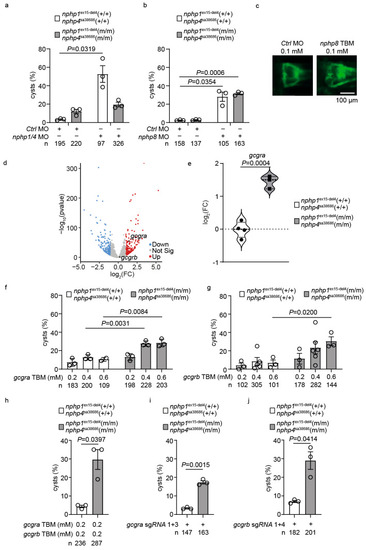
GLP-1/glucagon receptor depletion enhances cystogenesis in nphp1ex15-del4;nphp4sa38686 double mutant zebrafish. (a) Quantification of cyst formation in nphp1ex15-del4;nphp4sa38686 homozygous mutant embryos (m/m) and wild-type siblings (+/+) injected with nphp1/nphp4 MO shows the resistance of mutants to morpholino effects. (b) Both nphp1ex15-del4;nphp4sa38686 homozygous mutants and wild-type siblings remain sensitive to nphp8 MO-induced cyst formation. (c) Representative fluorescence microscopy images showing normal glomerular morphology in control MO-injected nphp1ex15-del4;nphp4sa38686 homozygous mutant embryos and cyst formation following nphp8 TBM injection. Bar = 100 µm. Data are presented as mean ± SEM. Each circle represents an independent experiment. The total number of embryos analyzed per condition (n) is indicated below each graph. (d) The volcano plot of RNA sequencing data comparing double mutants to wild-type siblings reveals the significant upregulation of gcgra (log2FC = 1.5), but not of gcgrb (log2FC = 0.2). (e) Violin plot showing the log2FC of gcgra expression from RNA sequencing data comparing nphp1ex15-del4;nphp4sa38686 homozygous mutants (m/m) to wild-type siblings (+/+). Adj. p-value is shown. (f) Dose-dependent increase in cyst formation following gcgra TBM injection in nphp1ex15-del4;nphp4sa38686 homozygous mutant embryos compared to their wild-type siblings. (g) Similar dose-dependent enhancement of cystogenesis by gcgrb TBM in the nphp1ex15-del4;nphp4sa38686 homozygous mutant background. (h) The combined knockdown of gcgra and gcgrb shows enhanced cyst formation, specifically in nphp1ex15-del4;nphp4sa38686 homozygous mutant embryos. (i,j) The sgRNA-mediated targeting of gcgra or gcgrb leads to increased cyst formation in nphp1ex15-del4;nphp4sa38686 homozygous mutant embryos. Bar = 100 µm.
|